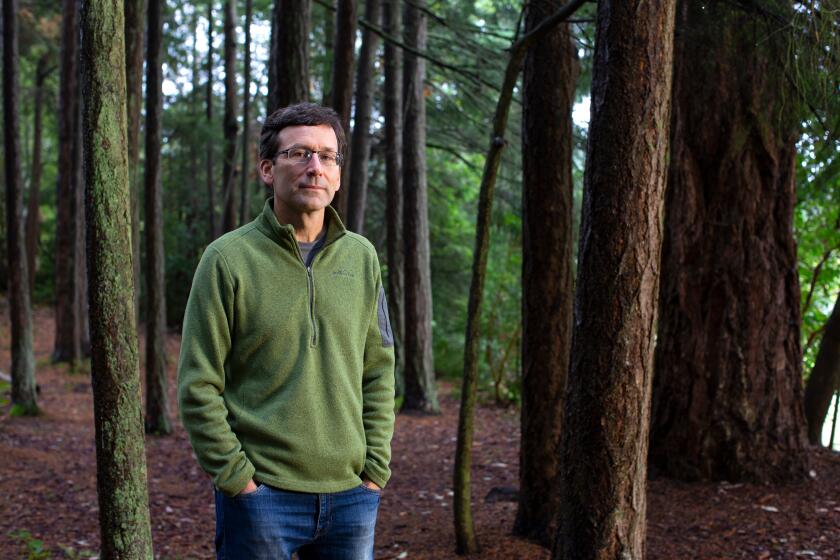A plan to sell a federal archives building in Seattle hits trouble: âThe DNA of our region is located thereâ
SEATTLE â Feliks Banel, a Seattle historian and radio host, sounded the alarm in January when a listener alerted him to an obscure notice on a website monitoring government real estate.
Among the dozen âhigh value assetsâ tapped to be put up for sale was the Federal Archives and Record Center â a hulking building here that has long been a treasure trove for anybody interested in the history of the Pacific Northwest or Alaska.
âThe 19th century changed the Northwest part of the United States from the way it had been for thousands of years,â said Banel, who produces history features for KIRO-FM (97.3). âThe federal government was the biggest player in altering the landscape and culture, and all the records of it â and any hope of understanding what went wrong or what went right â are in that building.â
The plan to sell the building as soon as early next year and move its contents to archive centers in California and Missouri set off a fight between the Trump administration and regional historians, political leaders and Native Americans, who say that preserving local access to the collection is crucial.
Washington stateâs attorney general, Bob Ferguson, said Friday that he intended to file a lawsuit to block the sale, arguing that the U.S. Office of Management and Budget had decided to unload the property without properly notifying the public or soliciting opinions from Native American tribes and other groups.
âWhatâs so maddening about this decision is that you have no process, you notify nobody, and youâre going to treat this property like some random warehouse that simply needs to be sold,â he said in an interview with The Times. âThe DNA of our region is located there, and for the federal government to treat it so cavalierly is frustrating.â
Bipartisan opposition to the sale includes all U.S. senators from Washington, Oregon, Idaho and Alaska as well as eight House members. One hope is that the Biden administration will stop it.
Situated on 10 acres along Lake Washington, the 200,000-square-foot building houses about a million boxes of source documents and public land, court, military, tax and census records, most in original form, as well as microfilm publications.
The collection includes treaty documents for more than 270 federally recognized tribes and records from camps where U.S. citizens of Japanese ancestry were imprisoned during World War II.
There are sketches of the Aleutian Islands viewed from a boat in the 1890s and Forest Service teletypes sent when Mount St. Helens erupted in 1980.
About 50,000 files stem from the Chinese Exclusion Act of 1882 â which aimed to limit the influx of laborers from China â including biographical details, letters, photographs and interrogation notes on Chinese who entered through ports in Washington and Oregon.
A 1907 photograph in Case File 1483 shows a solemn 9-year-old girl named Soong May-ling, who would one day become the first lady of Taiwan. Madame Chiang Kai Shek helped lobby for the repeal of the Exclusion Act.
Seattle-area volunteers have been indexing the Exclusion Act files, creating an extensive database of family history.
Retaining the archives in the Northwest is especially important to Native Americans, said Jon Shellenberger, lead Yakama Nation archaeologist.
âWeâve had to adapt and use paper as our own weapon to fight for our sovereignty,â he said. âAnd itâs all right there in that collection.â
Brandon Reynon, the historic preservation officer for the Puyallup Tribe, said that dividing and moving the collection would place yet more obstacles in the paths of Native Americans whose history was brushed aside by government-funded schools bent on assimilation.
âThe mission of the boarding schools was to erase our history, which in some cases was literally beaten out of us,â he said.
The move further aggravates many Alaskans, who lost local access to federal records in 2014, when the National Archives collection in Anchorage was moved to the Seattle building.
âThere was a huge outcry from people when it was made public,â said Pennelope Goforth, an Anchorage writer and historian. âThe promise was, âWell, weâre going to digitize a lot of this material, so no worries.ââ
Bob Ferguson, Washington stateâs attorney general, has sued the Trump administration over mostly environmental and immigration issues.
According to a report prepared for the Public Buildings Reform Board â a five-member government committee that had first recommended the sale â the Seattle building has a deferred maintenance backlog of $2.4 million and annual operating and maintenance costs exceeding $350,000.
Talmage Hocker, a Kentucky commercial real-estate executive appointed to the board by President Trump in 2018, said in a brief interview Friday that the property remained on track to be sold next year in a portfolio with other federal real estate.
Hocker said that the board had no authority to consider a facilityâs relevance to a region. A lot of the properties âare old and obsolete and need to be combined,â he said.
Sale of the Seattle property, considered a prime spot for condo towers with lake and mountain views, means that it will finally start generating tax revenues, he said.
âThis building does not receive a tremendous amount of visitors,â he said. âIt can become a part of the community, as opposed to what it is today.â
Ferguson called Hockerâs notion that the archives were not part of the community âoffensive.â
âIt demonstrates they have no idea what theyâre doing with this property or what it means to this region,â he said. âThat statement reflects the federal governmentâs utter disregard for tribal and other communities for whom this facility holds invaluable and irreplaceable historical records.â
Ferguson said that his late father, a Boeing worker fascinated by history, was a regular at the Seattle archives. âHe loved the place,â Ferguson said.
The land that the building now occupies was once farmed by the Uyeji family, which had been in the United States for decades when the federal government â in 1942 â ordered 120,000 people of Japanese ancestry into internment camps.
Even after the Uyejis were freed, they never returned to the farm, which was sold and then condemned by the U.S. Navy to build a warehouse, according to an archivist cited by Fergusonâs office in an August news release.
The warehouse later became the archives building. The collection includes a key to the front door of the familyâs former home.
More to Read
Sign up for Essential California
The most important California stories and recommendations in your inbox every morning.
You may occasionally receive promotional content from the Los Angeles Times.












